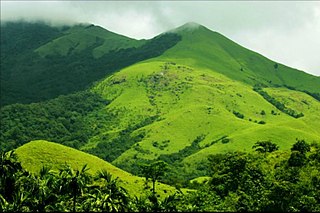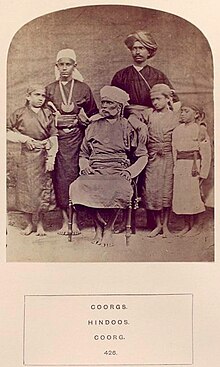
Kodagu district is an administrative district in the Karnataka state of India. Before 1956, it was an administratively separate Coorg State at which point it was merged into an enlarged Mysore State.

Madikeri is city and headquarters of Kodagu district in the Karnataka state of India. It is recognised as one of the world's eight "hottest hotspots" of biological diversity and also one of UNESCO World Heritage Sites. The city is ranked 1st in India for having cleanest air and best AQI in 2024.

The Kodavas also called Coorgs are an endogamous Dravidian ethnolinguistic group from the region of Kodagu in the southern Indian state of Karnataka, who natively speak the Kodava language. Kodavas worship ancestors, nature, and weapons such as swords, bows, arrows, and later guns.

Chikavira Rajendra or Chikka Vira Rajendra, was the last ruler of the Kodagu (Coorg) kingdom in South India. His actual name was Vira Rajendra, but this was the name of his uncle as well; as both of them were rulers of Kodagu, the prefix Chikka is used as a distinguisher. He was a son of Linga Rajendra II.
The town of Virajpet also spelled as Virajapete is town of the district of Kodagu, in India's southern State of Karnataka. It is the main town of the Virajpet taluka, south of the district, and borders Kerala State. The name of the town is derived from its founder, Dodda Vira Rajendra.

The district of Kodagu in present-day Karnataka comprises the area of the former princely state of the same name.

Bhagamandala is a pilgrimage place in Kodagu district of the Indian state of Karnataka.

Nalknad Palace or Nalkunadu, called Naalnaad Aramane in the local Kodava language, is a palace located in the Kodagu district of the Indian state of Karnataka. It is located near a village named Yavakapadi and was built between the years 1792 and 1794 AD. This palace was the last refuge of the last of the Haleri kings of Kodagu, Chikka Veerarajendra before he was deposed by the British. The Kannada film Shanti, which has only a single actor, was shot in the surroundings of the palace.

Ponnampet or Ponnampēte is a taluk headquarters in the southern part of the district of Kodagu in the state of Karnataka.Ponnampet taluk came into existence on 29 November 2020.
The captivity of Kodavas (Coorgis) at Seringapatam was the period of capture, deportation, and imprisonment of Kodava Takk speaking kodavas who rebelled against Tippu Sultan, the de facto ruler of the Kingdom of Mysore, they (60,000-70,000) were caught during a number of attempts to suppress their rebellion in the 1780s.

The Coorg War was fought between the British East India Company and the State of Coorg in 1834. Defiance of the Raja of Coorg, a small state in South India, led to a short but bloody campaign in 1834. In February 1834, a force of 7,000 was assembled under the command of Brigadier General Lindsay to commence operations against the Raja, who had begun hostilities against the British. Due to the poor state of roads, the force was divided into four columns, which were to enter Coorg from different directions and converge on the capital of Mercara. On 11 March, the Northern Division under the command of Colonel Gilbert Waugh entered the territory of Coorg and on 3 April, the leading troops made contact with the enemy. At noon, the advanced guard arrived in front of the fortified position of Soamwar Pettah. The force launched an attack on the position but was forced to retreat after a severe mauling. The leader of the Coorg resistance was 'Madanta' (Mathanda) Appachu. Similar fate was suffered by another column.

Coorg State was a Part-C state in India which existed from 1950 to 1956. When the Constitution of India came into force on 26 January 1950, most of the existing provinces were reconstituted into states. Thus, Coorg Province became Coorg State. Coorg State was ruled by a Chief Commissioner with Mercara as its capital. The head of the government was the Chief Minister. Coorg State was abolished on 1 November 1956 as per the States Reorganisation Act, 1956 and its territory was merged with Mysore State. Currently, Coorg forms a district of Karnataka state.

The Kingdom of Coorg was an independent kingdom that existed in India from the 16th century until 1834. It was ruled by a branch of the Ikkeri Nayaka. From 1780 to 1788, the kingdom was occupied by neighbouring Mysore but the Rajah of Coorg was restored by the British and became a protectorate of the British East India Company on 26 October 1790. In 1834, the then Raja of Coorg rebelled against British authority, sparking the Coorg War. The brief conflict led to the British to annex the kingdom in the same year, who transformed the region into a province of British India.

The St. Mark's Church, is located within the Mercara Fort, Coorg, India and was raised in 1859, by the officers and men of the East India Company. The church building was funded by the Government of Madras, and placed under the Church of England in India, Diocese of Madras. The Church was closed after Indian independence, and taken over by the Government of Karnataka in 1971. The building now houses the Madikeri Fort Museum, managed by the Karnataka State Archaeological Department.

Linga Rajendra II or Linga Raja II was the ruler of Kodagu Kingdom (r.1811–1820). He renovated Madikeri Fort's Palace between 1812 and 1814.
Dodda Vira Rajendra was the ruler of the Kingdom of Coorg from 1780 to 1809. He freed the kingdom from the occupation of Tipu Sultan, the king of Mysore. He later aided the British in their fight against Tipu Sultan. Dodda Veera raja constructed the city of Virarajendrapete, today known as Virajapet.

The Amara Sullia Rebellion was an armed uprising against the British government organized by the people of Arebhashe, and Tulunadu that took place in 1837, twenty years before the Sepoy Mutiny of 1857.
Kalyatanda Ponnappa was a 17th-century warrior of Kodagu (Coorg). Since he was deified after his death, the people of Kodagu consider him to be a god. He is also known as Kaliat-Achchappa or Kaliat Ajjappa.

Guddemane Appaiah Gowda was an Indian freedom fighter and revolutionary, he instated a peasant army from Kodagu and became its commander in-chief to lead the Amara Sullia Rebellion in 1837. His great grandson Sujith Guddemane is prominent lawyer from Sullia, practising before the High Court of Karnataka. They were successful in hoisting the native flag after lowering the Union Jack, which is known to be the first-ever freedom movement against the East India Company. They established a civil government in Mangalore for 13 days under his leadership.
Kannanda Doddayya was a Kodava commander who defeated Hyder Ali's forces thrice. He was also known as Kannana Doddayya and Doddanna.















